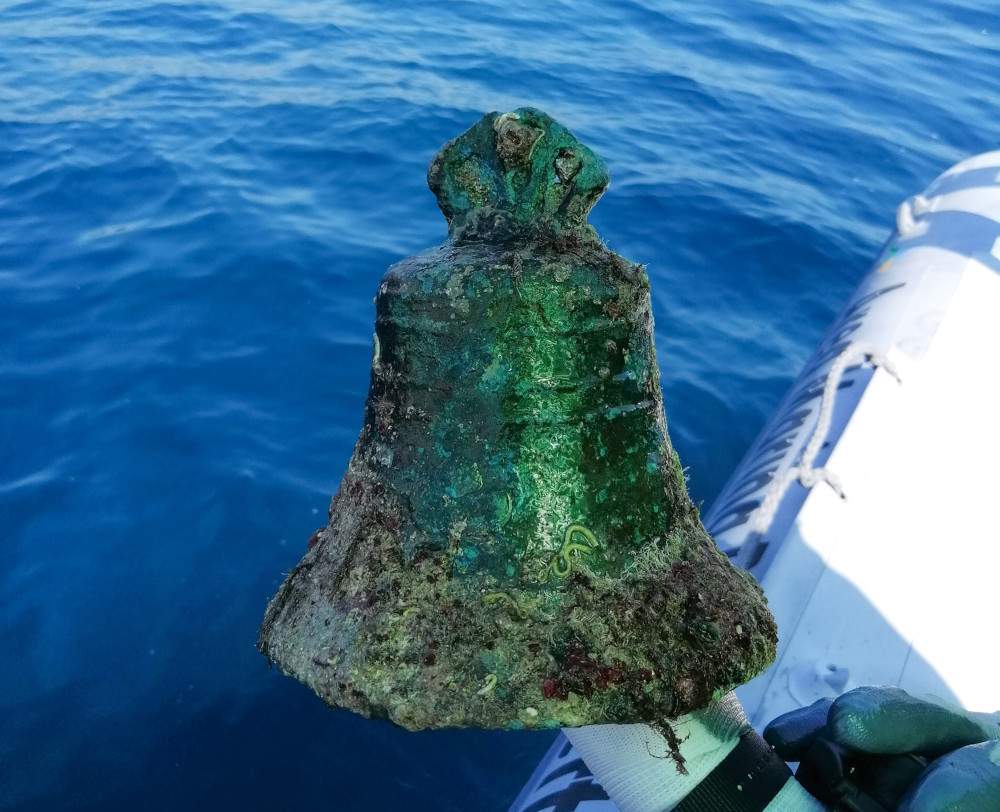Important find in the waters off Capo Rizzuto: the wreckage of a shipwrecked ship's bell
In the waters of Capo Rizzuto, in the province of Crotone, the wreck of a bell has been found: the discovery is being investigated by the National Superintendence for Underwater Cultural Heritage headed by Barbara Davidde and the Superintendence of Archaeology, Fine Arts and Landscape for the provinces of Catanzaro and Crotone headed by Fabrizio Sudano. Also involved are the Capo Rizzuto Marine Protected Area, the Regional Marine Strategy Center of Arpa Calabria based in Crotone and the Carabinieri Scuba Diving Unit of Messina.
“In May 2019, some local divers (Francesco Megna, Simone Megna, Luca De Rosa and Franco Megna),” explains Fabrizio Sudano, “found some cannons near Capo Rizzuto and reported their discovery to the authorities. After an initial inspection, the two Superintendencies decided to initiate, with a view to protection, some underwater investigations whose scientific activities were directed by underwater archaeologists Salvatore Medaglia and Paola Caruso belonging to the two institutes of the Ministry of Culture.”
In the waters of the Capo Rizzuto Marine Area, a marine park established in 1991 that covers 14,721 hectares,“ adds Barbara Davidde, ”nine cannons scattered chaotically in an area of rocky shallows have been surveyed. These are cast-iron artillery pieces of different sizes and calibers lying on a seabed between 6 and 10 meters deep. Also discovered around the muzzle-loading guns were two huge iron anchors, the largest of which is about two meters long."
After painstaking cleaning work carried out to better define the state of preservation of the artillery pieces, archaeologists carried out detailed documentation of the individual artifacts and a search of the seabed with the valuable support of Carabinieri divers led by Commander Domenico De Giorgio. In the course of the search, a bronze bell referable to the wrecked ship was found. In a fairly good state of preservation, the bell has various marine encrustations and features some decorations in relief. This is an important find that has created excitement among archaeologists, who hope to derive information to chronologically frame the wreck, which for the time being remains unspecified.
“Among the equipment on board,” explains underwater archaeologist Salvatore Medaglia of the Taranto-based Superintendency of Underwater Heritage, “the bell certainly had an important role, with, if you will, symbolic value. Hanging on the castle at the time of the sailing navy, it marked the passage of time and warned the crew of the alternation of the various daily activities. It also served as an acoustic beacon, for example in case of fog or for immediate danger. Not infrequently the bell bore the year of casting and sometimes the mark of the craftsman who had made it. To these elements could further be added the name of the ship and the emblem of the navy or the coat of arms of the state under whose flag it sailed. That’s why it’s so important to us as researchers with a view to wanting to give the wreck an identity.”
The bell was transported by Carabinieri from the Nucleo Tutela Patrimonio Culturale in Cosenza, and in the next few hours it will be entrusted to a restorer expert in metal treatment, who works within the laboratory of the ABAP Superintendency of Cosenza. We will have to wait for the detailed examination and restoration of the find to have some more news about the bell.
The Capo Rizzuto marine area, in which the remains of the shipwreck are located, is already known to archaeologists. It is in these very waters that there are other traces of shipwrecks: the most famous of these is the steamer Bengal of the Italian General Navigation fleet, which, launched in Sunderland in 1872, sank in 1889 causing the death of two crew members. Then there are two other shipwreck-related archaeological deposits, which can be framed between the 17th and 18th centuries, that are located a short distance from the bell wreck. The first of these is a shipwreck that possibly began its voyage in Narbonne and carried a varied lithic cargo composed of marbles from the quarries of Caunes Minervois in France (also known as the red mischio of France), Portovenere (black marble), and Carrara; the other, lying on a seabed of about 8 meters, has returned more cannons, also made of cast iron.
The reason why these wrecks are concentrated in these waters is presumably due to the presence of some shoals that, at least until the end of the eighteenth century, were semi-submerged. These constituted a real trap for the unfortunate vessels that had the misfortune to run into them. Many portolans of the modern age, dated mainly between the 15th and 18th centuries, recall the danger of these shoals, and numerous archival documents preserve memories of shipwrecks that occurred between the 16th and 19th centuries in this stretch of sea. Added to the pitfalls of the rocky shoals was piracy, predominantly Barbary, which was very virulent along the Calabrian Ionian Sea and of which there is ample evidence in the historical record.
Investigations will continue in the coming months with the intention of finding parts of the hull that may have been preserved in some of the large sandy pockets with which the seabed is studded. The area of the investigation is being monitored by law enforcement through surveillance devices, including remotely.
 |
| Important find in the waters off Capo Rizzuto: the wreckage of a shipwrecked ship's bell |
Warning: the translation into English of the original Italian article was created using automatic tools. We undertake to review all articles, but we do not guarantee the total absence of inaccuracies in the translation due to the program. You can find the original by clicking on the ITA button. If you find any mistake,please contact us.





























